The Samsung Galaxy Note7 (S820) Review
by Joshua Ho on August 16, 2016 9:00 AM ESTSystem Performance Cont'd
Now that we've covered more general purpose benchmarks that tend to emphasize CPU performance and GPU compute performance, we can look at benchmarks that tend to more strongly emphasize things that games will see benefits from such as improved GPU graphics performance and improved CPU physics processing performance.
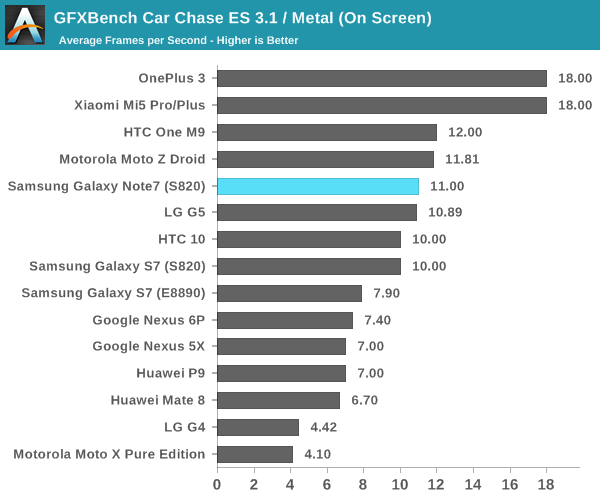
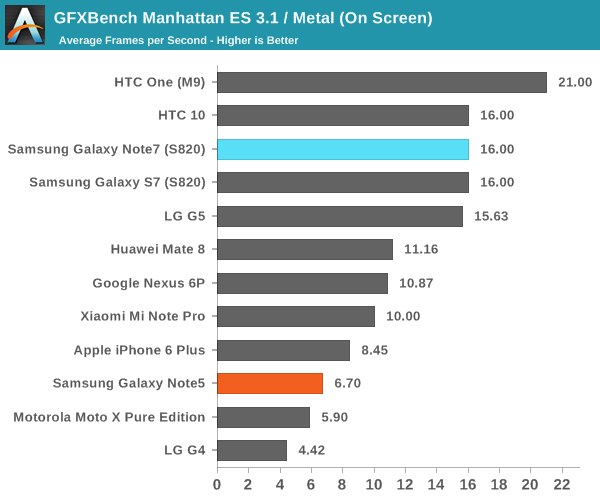
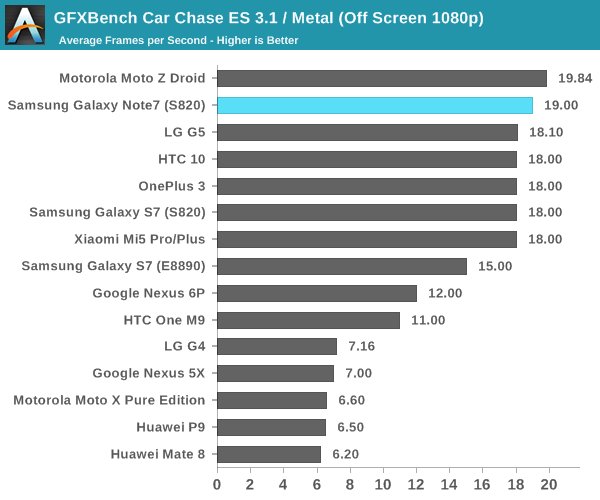
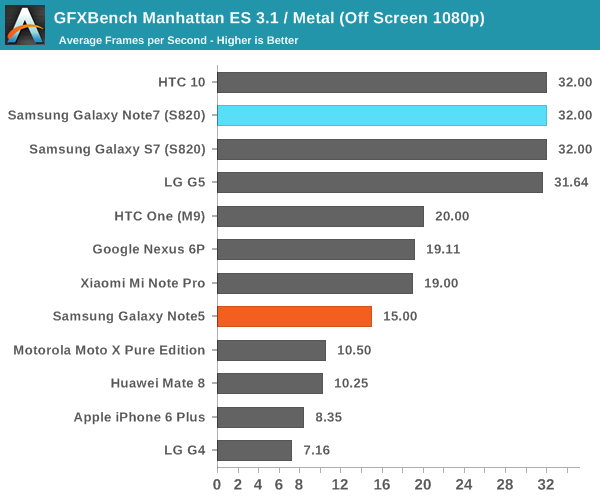

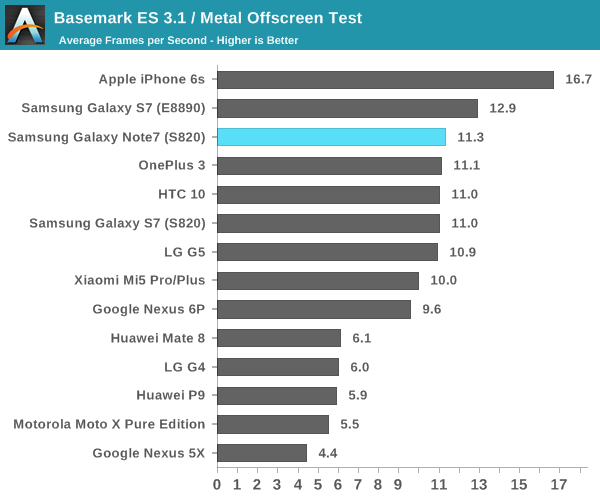
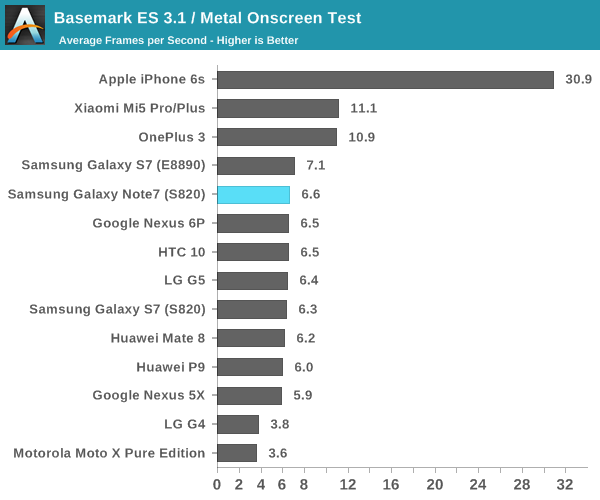
It's probably no surprise, but the Galaxy Note7 performs as expected with the latest drivers and in ideal thermal conditions. The Adreno 530 should be more than sufficient for the forseeable future but for maximum performance it's best to enable 1080p rendering or lower to maximize frame rates in games like Real Racing 3 that tend to really use the GPU to its fullest extent.
NAND Performance
Of course, while Discomark provides a sort of holistic view of performance for a specific task, it’s also important to at least try and break down the various aspects that impact system performance so rather than simple black box testing we can further understand what factors influence performance and therefore provide additional information to make better buying decisions. One of the major contributors to general purpose performance is going to be storage performance, which is often something often ignored by marketing as the nitty gritty details of NAND storage realistically require some background in solid state physics and devices to understand, as well as some understanding of computer science and engineering.
While I’m not really happy with the state of our mobile storage benchmarks, for now I don’t really see another option here as the publicly available storage benchmarks for Android and iOS are fairly basic. Putting aside the state of the benchmarking industry, our current benchmark remains AndroBench 4 which provides at least some basic storage benchmarking capabilities. We use custom settings with this benchmark which attempts to make the test more realistic as the default settings are just wildly unrealistic. This includes adjusting the buffer size, increasing the file size to 100 MB, and only using one thread instead of 8. 256KB file size is targeted as this is the most common block size if you profile this kind of thing for sequential writes and reads, while 4KB block sizes are the most common for other tasks as the vast majority of computer architectures use 4KB pages for virtual memory. Single-threaded I/O is common in most cases because multi-threaded programming is still difficult for most people to reason about in an effective manner because conscious thought is inherently serial in nature with some multiplexing. In addition to this, many eMMC solutions on the market don’t really perform well with multiple threads simultaneously as the controller can’t do anything with extra requests other than reply with a busy signal which already happens with a single thread.
Putting aside discussions of testing we can take a look at the storage solution used in the Galaxy Note7 before getting into the actual results. The Note7 continues to use basically the same storage solution as the Galaxy S7 and S6, which is to say an MLC-based solution that has a UFS Gear 3 single lane interface for bandwidth up to 600 MB/s and basically has the exact same model number if you check the SCSI devices attached to the system save for some changes that indicate the higher 64GB storage relative to the 32GB chips that are most common in the Galaxy S7.
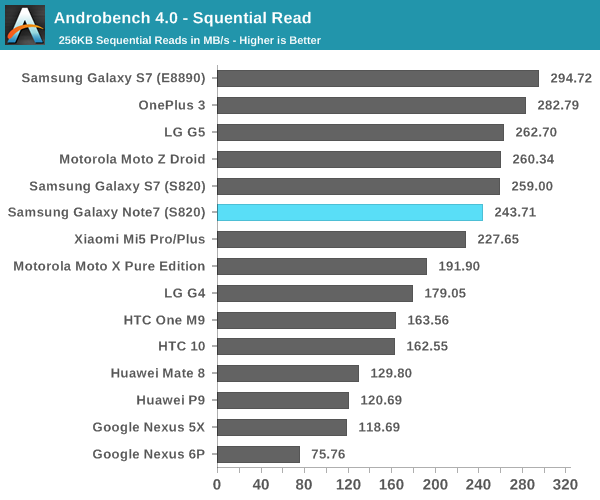

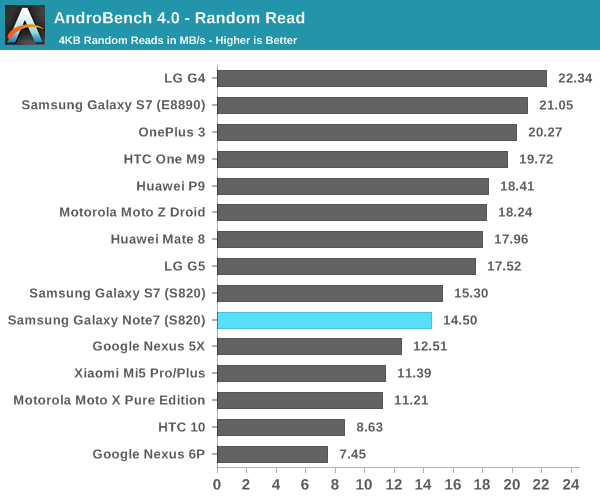
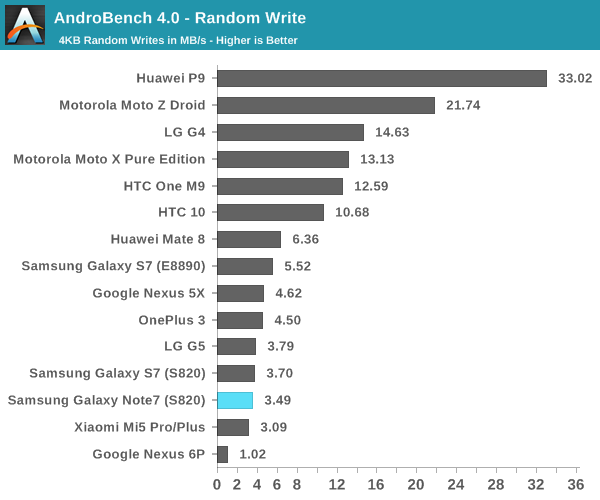
Looking at the test results it performs exactly as quickly as you’d expect from this MLC solution as we’ve tested it in the Galaxy S6, S6 edge, S6 edge+, Note5, S7, S7 edge, and now the Note7 as well as the LG G5. The performance here is acceptable but obviously if you look at burst performance the iPhone 6s has a faster solution due to the hybrid SLC/TLC storage solution. The main benefit of pure MLC NAND is that performance is more consistent as there’s no precipitous drop when the SLC buffer fills. There’s always room to improve but I don’t really see how it’s going to happen unless Samsung moves to V-NAND for the next generation.










202 Comments
View All Comments
Cygni - Tuesday, August 16, 2016 - link
I would like to see Anandtech stick to its guns and go back to calling "USB 3.1 Gen1" what it really is, USB 3.0. I remember a previous AT article announcing that the site wouldn't be supporting that marketing crap.TheinsanegamerN - Tuesday, August 16, 2016 - link
nice phone, but not worth anywhere near the money samsung is asking, between the fragile construction and the sealed battery. Note 4 is a much better buy, even at this point.keg504 - Tuesday, August 16, 2016 - link
Is the Galaxy Note 5 stylized as Note5 or is just an error on the first page? I have seen this in other places as Note5, so it's gotten me curiousPolizei608 - Tuesday, August 16, 2016 - link
Thanks Joshua for the review, greatly appreciate it and the timing! I'm a big HTC fan because of the smoothness of their sense experience, and this seems to be overlooked in every smartphone review. I was about to pull the trigger on the note 7 after doing endless review reading, and then I read your final words regarding real world use and was extremely happy I didjhoff80 - Tuesday, August 16, 2016 - link
So the USB-C port uses Samsung and Qualcomm's fast charge, making it not actually compliant with the USB specification? Why wouldn't they just use USB-PD other than 'because Samsung'?vLsL2VnDmWjoTByaVLxb - Tuesday, August 16, 2016 - link
You say:"Looking at the overall charge time the Galaxy Note7 performs respectably as it reaches full charge in under an hour and takes basically as much time as the Galaxy S7 edge, which is probably not a surprise given their similar battery capacities."
But your chart shows the shortest charge time at 1.33 hours (Galaxy Nexus 5X)? And the Note 7 at 1.85 hours? Am I reading this wrong?
Which is strange, because my S6 has never taken more than 1h20s to charge, and I'm pretty sure many phones beat my S6 on charging...
lilmoe - Tuesday, August 16, 2016 - link
With all due respect, this review provides NOTHING additional to what's been said and written online about the Note7/GS7 series. We come here for deep dives, SoC comparisons, software features that affect performance, etc......This review is nothing but personal opinion.
"The S-Pen continues to work well although I very rarely have any use for it"
Really? Like REALLY? Is that all you have to say about the absolute hallmark of this particular device??? No mention of the actual hardware improvements/regressions/whatever? No mention of its responsiveness or lack thereof? You think anyone gives a rat's ass about force touch? But you all still wrote paragraphs about a freagin' iGIMMICK.
Also Again??? No mention of throttling? No mention of the new power saving features? No mention of Game Tuner? No deep dive of the different SoCs???? Not a single attempt at tinkering with the kernel/governor to get a freakin' glimpse of what the heck is going on?????????
What's wrong with you guys???
amdwilliam1985 - Tuesday, August 16, 2016 - link
Well, get use to it.If it's a feature that iPhone has, then it will get mentioned.
If it's a feature that iPhone doesn't have, then it's "irrelevant".
Just wait till iPhone 7 Pro gets a stylus and iPhone 8 gets a iris scanner, then you will get paragraphs after paragraphs about how amazing they were.
As a reader, we can do selective reading as well. When it's about 3D-touching, my mind goes blah blah blah, irrelevant. Coming up to live phones, blah blah blah, irrelevant, next paragraph.
whiteiphoneproblems - Tuesday, August 16, 2016 - link
This is the sixth Galaxy Note with a stylus. I have no doubt that when Anandtech reviews the sixth iPhone model with 3D Touch, they will say little more beyond it "continues to work well."Oyeve - Wednesday, August 17, 2016 - link
I hear ya. Its like the reviewer was intentionally looking for something NOT to like. He goes on about mic hole placement and useless crap like that. Ironically this site waxes on the iphone symmetry so much like its an amazing feature. If it wasn't for the forums I wouldn't even come here anymore.